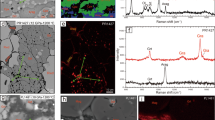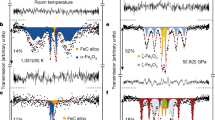Abstract
The oxidation state of iron in Earth’s mantle is well known to depths of approximately 200 km, but has not been characterized in samples from the lowermost upper mantle (200–410 km depth) or the transition zone (410–660 km depth). Natural samples from the deep (>200 km) mantle are extremely rare, and are usually only found as inclusions in diamonds. Here we use synchrotron Mössbauer source spectroscopy complemented by single-crystal X-ray diffraction to measure the oxidation state of Fe in inclusions of ultra-high pressure majoritic garnet in diamond. The garnets show a pronounced increase in oxidation state with depth, with Fe3+/(Fe3++ Fe2+) increasing from 0.08 at approximately 240 km depth to 0.30 at approximately 500 km depth. The latter majorites, which come from pyroxenitic bulk compositions, are twice as rich in Fe3+ as the most oxidized garnets from the shallow mantle. Corresponding oxygen fugacities are above the upper stability limit of Fe metal. This implies that the increase in oxidation state is unconnected to disproportionation of Fe2+ to Fe3+ plus Fe0. Instead, the Fe3+ increase with depth is consistent with the hypothesis that carbonated fluids or melts are the oxidizing agents responsible for the high Fe3+ contents of the inclusions.
This is a preview of subscription content, access via your institution
Access options
Access Nature and 54 other Nature Portfolio journals
Get Nature+, our best-value online-access subscription
$29.99 / 30 days
cancel any time
Subscribe to this journal
Receive 12 print issues and online access
$259.00 per year
only $21.58 per issue
Buy this article
- Purchase on Springer Link
- Instant access to full article PDF
Prices may be subject to local taxes which are calculated during checkout


Similar content being viewed by others
References
McDonough, W. F. & Sun, S. S. The Composition of the Earth. Chem. Geol. 120, 223–253 (1995).
Canil, D. et al. Ferric iron in peridotites and mantle oxidation states. Earth Planet. Sci. Lett. 123, 205–220 (1994).
Wood, B. J., Bryndzia, L. T. & Johnson, K. E. Mantle oxidation state and its relationship to tectonic environment and fluid speciation. Science 248, 337–345 (1990).
Frost, D. J. & McCammon, C. A. The redox state of Earth's mantle. Annu. Rev. Earth Planet. Sci. 36, 389–420 (2008).
Woodland, A. B. & Koch, M. Variation in oxygen fugacity with depth in the upper mantle beneath the Kaapvaal craton, Southern Africa. Earth Planet. Sci. Lett. 214, 295–310 (2003).
Gudmundsson, G. & Wood, B. J. Experimental tests of garnet peridotite oxygen barometry. Contrib. Mineral. Petrol. 119, 56–67 (1995).
Ballhaus, C. Is the upper mantle metal-saturated. Earth Planet. Sci. Lett. 132, 75–86 (1995).
Jacob, D. E., Kronz, A. & Viljoen, K. S. Cohenite, native iron and troilite inclusions in garnets from polycrystalline diamond aggregates. Contrib. Mineral. Petrol. 146, 566–576 (2004).
Sobolev, N. V., Efimova, E. S. & Pospelova, L. N. Native iron in diamonds of Yakutia and its paragenesis. Geol. Geofiz. 22, 25–28 (1981).
Smith, E. M. et al. Large gem diamonds from metallic liquid in Earth’s deep mantle. Science 354, 1403–1405 (2016).
Golubkova, A., Schmidt, M. W. & Connolly, J. A. D. Ultra-reducing conditions in average mantle peridotites and in podiform chromitites: A thermodynamic model for moissanite (SiC) formation. Contrib. Mineral. Petrol. 171, 1–17 (2016).
Beyer, C. & Frost, D. J. The depth of sub-lithospheric diamond formation and the redistribution of carbon in the deep mantle. Earth Planet. Sci. Lett. 461, 30–39 (2017).
Irifune, T. & Ringwood, A. E. in High-pressure Research in Mineral Physics Vol. 1 (eds Manghnani, M. H. & Syono, Y.) 235–246 (Terra Scientific, Tokyo, 1987).
Wood, B. J., Kiseeva, E. S. & Matzen, A. K. Garnet in the Earth's Mantle. Elements 9, 421–426 (2013).
Irifune, T. & Ringwood, A. E. Phase transformations in a harzburgite composition to 26 GPa—implications for dynamical behavior of the subducting slab. Earth Planet. Sci. Lett. 86, 365–376 (1987).
Kiseeva, E. S. et al. Metapyroxenite in the mantle transition zone revealed from majorite inclusions in diamonds. Geology 41, 883–886 (2013).
Pearson, D. G., Davies, G. R. & Nixon, P. H. Geochemical constraints on the petrogenesis of diamond facies pyroxenites from the Beni Bousera peridotite massif, North Morocco. J. Petrol. 34, 125–172 (1993).
Kiseeva, E. S., Wood, B. J., Ghosh, S. & Stachel, T. The pyroxenite–diamond connection. Geochem. Perspect. Lett. 2, 1–9 (2016).
Thomson, A. R., Walter, M. J., Kohn, S. C. & Brooker, R. A. Slab melting as a barrier to deep carbon subduction. Nature 529, 76–79 (2016).
Rohrbach, A. et al. Metal saturation in the upper mantle. Nature 449, 456–458 (2007).
Holland, T. J., Hudson, N. F., Powell, R. & Harte, B. New thermodynamic models and calculated phase equilibria in NCFMAS for basic and ultrabasic compositions through the transition zone into the uppermost lower mantle. J. Petrol. 54, 1901–1920 (2013).
Holland, T. J. B. & Powell, R. An improved and extended internally consistent thermodynamic dataset for phases of petrological interest, involving a new equation of state for solids. J. Metamorph. Geol. 29, 333–383 (2011).
Mckenzie, D. & Bickle, M. J. The volume and composition of melt generated by extension of the lithosphere. J. Petrol. 29, 625–679 (1988).
Xu, C. et al. Recovery of an oxidized majorite inclusion from Earth’s deep asthenosphere. Sci. Adv. 3, e1601589 (2017).
Ickert, R. B., Stachel, T., Stern, R. A. & Harris, J. W. Extreme 18O-enrichment in majorite constrains a crustal origin of transition zone diamonds. Geochem. Perspect. Lett. 1, 65–74 (2015).
Tappert, R. et al. Diamonds from Jagersfontein (South Africa): Messengers from the sublithospheric mantle. Contrib. Mineral. Petrol. 150, 505–522 (2005).
Canil, D. & ONeill, H. S. C. Distribution of ferric iron in some upper-mantle assemblages. J. Petrol. 37, 609–635 (1996).
Goncharov, A. G., Ionov, D. A., Doucet, L. S. & Pokhilenko, L. N. Thermal state, oxygen fugacity and C–O–H fluid speciation in cratonic lithospheric mantle: new data on peridotite xenoliths from the Udachnaya kimberlite, Siberia. Earth Planet. Sci. Lett. 357, 99–110 (2012).
Lazarov, M., Woodland, A. B. & Brey, G. P. Thermal state and redox conditions of the Kaapvaal mantle: A study of xenoliths from the Finsch mine, South Africa. Lithos 112, 913–923 (2009).
Luth, R. W., Virgo, D., Boyd, F. R. & Wood, B. J. Ferric iron in mantle-derived garnets—implications for thermobarometry and for the oxidation state of the mantle. Contrib. Mineral. Petrol. 104, 56–72 (1990).
McCammon, C. & Kopylova, M. G. A redox profile of the Slave mantle and oxygen fugacity control in the cratonic mantle. Contrib. Mineral. Petrol. 148, 55–68 (2004).
Kopylova, M. G., Beausoleil, Y., Goncharov, A., Burgess, J. & Strand, P. Spatial distribution of eclogite in the Slave cratonic mantle: the role of subduction. Tectonophysics 672, 87–103 (2016).
Potapkin, V. et al. The 57Fe synchrotron Mössbauer source at the ESRF. J. Synchrotron Radiat. 19, 559–569 (2012).
Nestola, F. et al. Synchrotron Mössbauer source technique for in situ measurement of iron-bearing inclusions in natural diamonds. Lithos 265, 328–333 (2016).
Prescher, C., McCammon, C. & Dubrovinsky, L. MossA: a program for analyzing energy-domain Mössbauer spectra from conventional and synchrotron sources. J. Appl. Crystallogr. 45, 329–331 (2012).
Geiger, C. A. et al. A combined temperature dependent 57Fe Mössbauer and single crystal X-ray diffraction study of synthetic almandine: evidence for the Goldanskii–Karyagin effect. Phys. Chem. Miner. 19, 121–126 (1992).
Lyubutin, I. & Dodokin, A. Temperature dependence of Mössbauer effect for Fe2+ in dodecahedral coordination in garnet. Sov. Phys. Crystallogr. 15, 1091–1092 (1971).
Lyubutin, I., Dodokin, A. & Belyaev, L. Temperature dependence of Mössbauer effect for octahedral iron atoms in garnets. Sov. Phys. Solid State 12, 1100–1101 (1970).
McCammon, C. A. & Ross, N. L. Crystal chemistry of ferric iron in (Mg, Fe)(Si,Al)O3 majorite with implications for the transition zone. Phys. Chem. Miner. 30, 206–216 (2003).
Liermann, H. P. et al. The extreme conditions beamline P02.2 and the extreme conditions science infrastructure at PETRA III. J. Synchrotron Radiat. 22, 908–924 (2015).
CrysAlisPro v.171.38.43 (Agilent Technologies, 2013).
Petříček, V., Dušek, M. & Palatinus, L. Crystallographic computing system JANA2006: General features. Z. Krist. Cryst. Mater. 229, 345–352 (2014).
Stagno, V., Ojwang, D. O., McCammon, C. A. & Frost, D. J. The oxidation state of the mantle and the extraction of carbon from Earth's interior. Nature 493, 84–88 (2013).
Holmes, R. D., O’Neill, H. S. C. & Arculus, R. J. Standard Gibbs free energy of formation for Cu2O, NiO, CoO, and Fe x O: High-resolution electrochemical measurements using zirconia solid electrolytes from 900-1400 K. Geochim. Cosmochim. Acta 50, 2439–2452 (1986).
Ahrens, T. J. (Ed.) Mineral Physics and Crystallography: A Handbook of Physical Constants (American Geophysical Union, Washington DC, 1995).
Acknowledgements
We thank T. Holland for checking some of our calculations and D. Frost for providing his spreadsheet for oxygen fugacity calculations using garnet equilibria, A. Schönleber for discussion of XRD results and D. Simonova for assistance during Mössbauer experiments. We acknowledge support from European Research Council grant 267764 to B.J.W. and NERC grant NE/L010828/1 to E.S.K. Financial support was provided to L.D. and C.M. through DFG grants Mc 3/18-1 and Mc 3/20-1, and through BMBF grants. We acknowledge the European Synchrotron Radiation Facility for provision of synchrotron radiation facilities.
Author information
Authors and Affiliations
Contributions
Work was initiated and planned by E.S.K. and L.D. T.S. and J.W.H. provided the samples and their detailed description. M.B., D.M.V., E.B. and L.D. performed the X-ray diffraction measurements. D.M.V., M.B., E.B. and L.D. processed and analysed the diffraction data. D.M.V., V.C., A.C. and C.M. collected, processed and analysed the Mössbauer spectra. E.S.K. and B.J.W. interpreted the data, performed the thermodynamic calculations and prepared the manuscript. All co-authors read, commented and approved of the manuscript.
Corresponding author
Ethics declarations
Competing interests
The authors declare no competing financial interests.
Additional information
Publisher’s note: Springer Nature remains neutral with regard to jurisdictional claims in published maps and institutional affiliations.
Supplementary information
Supplementary Information
Supplementary data tables and figures
Rights and permissions
About this article
Cite this article
Kiseeva, E.S., Vasiukov, D.M., Wood, B.J. et al. Oxidized iron in garnets from the mantle transition zone. Nature Geosci 11, 144–147 (2018). https://doi.org/10.1038/s41561-017-0055-7
Received:
Accepted:
Published:
Issue Date:
DOI: https://doi.org/10.1038/s41561-017-0055-7
This article is cited by
-
Cubic Fe-bearing majorite synthesized at 18–25 GPa and 1000 °C: implications for element transport, subducted slab rheology and diamond formation
Scientific Reports (2023)
-
Extreme redox variations in a superdeep diamond from a subducted slab
Nature (2023)
-
Subduction-related oxidation of the sublithospheric mantle evidenced by ferropericlase and magnesiowüstite diamond inclusions
Nature Communications (2022)
-
The electrical conductivity of Fe4O5, Fe5O6, and Fe7O9 up to 60 GPa
Physics and Chemistry of Minerals (2022)
-
Recycled calcium carbonate is an efficient oxidation agent under deep upper mantle conditions
Communications Earth & Environment (2021)




